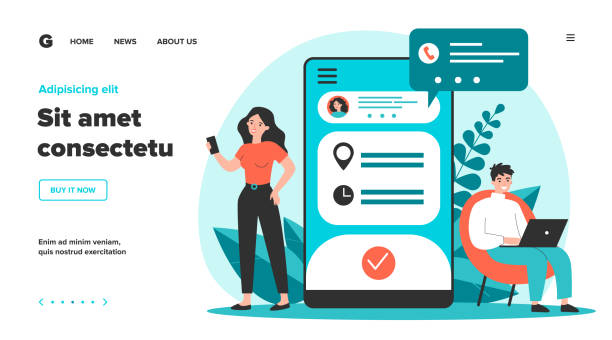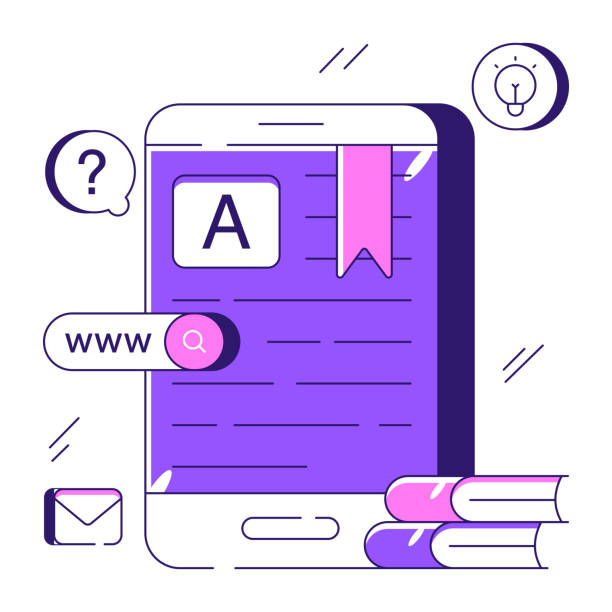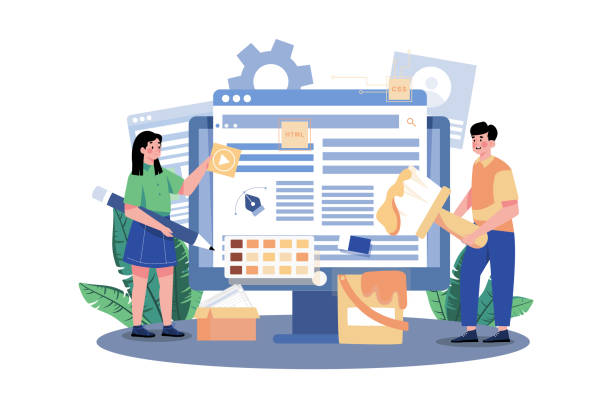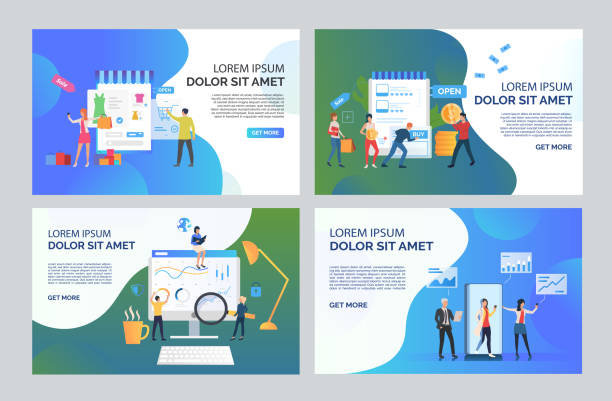Introduction to Responsive Design: Why Your Site Should Be Flexible?

In today’s digital world, where #internet_access via various devices such as #mobile, #tablet, and #laptop has become commonplace, the importance of #responsive_website_design is more evident than ever.
Responsive design or responsive web design means designing a website that has the #ability to automatically adapt to the user’s screen dimensions.
This approach ensures that your website is displayed optimally on any device, without the need for zooming, horizontal scrolling, or manual layout changes.
An optimal user experience, whether on mobile or desktop, is no longer an option, but a necessity.
This explanatory and educational content will help you gain a deeper understanding of this crucial concept.
In the past, website designs were often based on fixed desktop monitor dimensions, leading to a poor experience for mobile users.
However, with the significant increase in smartphone usage for web browsing, Google and other search engines also prioritize responsive websites.
This means that if your site is not responsive, it may drop in search result rankings.
Responsive website design is not only essential for SEO and improving your website’s visibility, but it also directly impacts your conversion rates and user satisfaction.
A website that looks good and performs well on all devices encourages users to stay longer and interact with the content.
This investment is crucial for the future of your online presence.
Does your company’s website create a professional and lasting first impression in the minds of potential customers? RasaWeb, with its professional corporate website design, not only represents your brand’s credibility but also opens a path for your business growth.
✅ Create a powerful and reliable brand image
✅ Attract target customers and increase sales
⚡ Get Free Consultation
Principles and Benefits of Responsive Design: Why Every Business Needs It?

#Responsive_website_design is built on three key principles: #Fluid_Grids, #Flexible_Images, and #Media_Queries.
#Fluid_Grids means that the website layout uses percentages and relative units instead of fixed pixel dimensions, to adapt itself to the screen size.
#Flexible_Images are coded to resize according to the available space, preventing the loading of large and heavy images on small devices.
Finally, Media_Queries are CSS rules that tell the browser how to display the website based on specific device characteristics such as width, height, resolution, or screen orientation (portrait/landscape).
This comprehensive approach offers numerous benefits.
Firstly, by having only one version of the site that works well on all devices, development and maintenance costs are significantly reduced. There is no longer a need for separate designs for mobile and desktop.
Secondly, User Experience (UX) is improved; users can access your content without any problems, which leads to increased satisfaction and loyalty.
Thirdly, from an SEO perspective, Google prefers responsive sites, and this type of design helps improve your ranking in search results.
A single URL for all devices means easier SEO management and avoids duplicate content issues.
This is an analytical and specialized guide for a deeper understanding of these principles.
Technical Architecture of Responsive Design: HTML, CSS, and Beyond

The #technical_architecture behind #responsive_website_design is mainly based on #HTML5 and #CSS3.
#HTML5 provides the semantic structure of the content, while #CSS3 is responsible for styling and adapting the website’s appearance.
The most important CSS3 component in this area is media queries, which allow developers to apply different CSS rules for different screen dimensions.
For example, you can set website columns to stack vertically on small screens and arrange horizontally on larger screens.
This is a specialized and educational section.
But responsive website design is not limited to HTML and CSS.
JavaScript can also play an important role in improving the responsive user experience, especially for more complex interactions and conditional content loading.
For example, JavaScript can be used to load higher quality images only on devices with Retina displays, or to implement mobile navigations that look different on desktop.
Also, “Mobile-First” approaches, which mean designing the website first for the smallest screen and then expanding it for larger screens, have become an industry standard.
This approach ensures that the site loads lightly and quickly on mobile devices, and additional elements for desktop are added only when needed.
Below is a comparative table of web design approaches:
| Feature | Responsive Design | Separate Mobile Site |
|---|---|---|
| URL | One URL for all devices | Two URLs (e.g., example.com and m.example.com) |
| Maintenance Cost | Lower (one codebase) | Higher (two codebases) |
| SEO | Optimized and favored by Google | More complex, requires redirect and canonical tag management |
| User Experience | Consistent and integrated across all devices | May cause issues when transferring between devices |
Popular Tools and Frameworks for Responsive Design

#Web_developers use numerous #tools and #frameworks for #responsive_website_design that make the design and implementation process much simpler and faster.
These tools help achieve a mobile-compatible design quickly without the need to code every section from scratch.
At the top of this list are CSS frameworks like Bootstrap and Foundation.
Bootstrap, developed by Twitter, is one of the most popular frameworks and includes a set of pre-built CSS elements and JavaScript components for responsive design.
These frameworks, with their automatic grid system, make working with responsive layouts very easy.
In addition to comprehensive frameworks, other tools are also available to assist with responsive website design.
For the educational aspect of this section, we can mention CSS preprocessors such as Sass and Less, which make CSS coding more efficient and organized with features like variables, functions, and mixins.
Also, browser developer tools in Chrome, Firefox, and Edge offer various device simulation capabilities that are very useful for testing and debugging responsive design.
These tools allow developers to see how the website looks and functions across different dimensions and resolutions.
Using these tools not only speeds up the process but also significantly increases the accuracy and final quality of the design.
Did you know that 94% of users’ first impressions of a business are related to its website design? With professional corporate website design by **RasaWeb**, turn this first impression into an opportunity for growth.
✅ Attract more customers and increase sales
✅ Build credibility and trust in the audience’s eyes⚡ Get a free website design consultation!
Testing and Validation of Responsive Design: Ensuring Flawless Performance

After implementing #responsive_website_design, the #testing and #validation phase is of particular importance.
Without thorough testing, it’s impossible to ensure that the website is displayed correctly and performs flawlessly across all devices and browsers.
One of the fundamental testing methods is using browser developer tools, which were also mentioned in the previous section.
These tools have the ability to change screen dimensions and simulate various devices.
This section provides guidance and specialized insights to ensure design quality.
However, relying solely on simulators is not enough.
Testing on real devices is crucial.
This includes testing on various smartphones (Android and iOS), tablets, and desktops with different browsers (Chrome, Firefox, Safari, Edge).
Performance issues, such as slow loading or incorrect element display, may only appear on real devices.
Tools like Google Mobile-Friendly Test can also help you evaluate your website’s responsiveness from Google’s perspective and provide reports on potential improvements.
Furthermore, checking site loading speed with tools like Google PageSpeed Insights, especially for mobile users who may have slower internet speeds, is vital.
These tests not only help identify problems but also ensure that your responsive design is truly optimized and provides an optimal user experience.
The Impact of Responsive Design on SEO and User Experience (UX)

#Responsive_website_design has a profound and direct impact on two vital aspects of your #online_success: #search_engine_optimization (#SEO) and #user_experience (#UX).
From an SEO perspective, Google has explicitly stated that it prefers responsive sites over sites with separate mobile versions.
The reason for this is the simplicity in crawling and indexing content by search engine spiders.
By having one URL for all devices, Google can understand your content more effectively and avoid duplicate content issues that may occur with separate mobile sites.
This aspect of the article is an important analytical and news section.
In addition, other factors such as site loading speed, bounce rate, and user session duration, all impact SEO, and responsive website design directly improves these factors. A site that loads quickly and is readable and navigable on any device will have a lower bounce rate and users will spend more time on it.
On the other hand, the impact on User Experience (UX) is also unparalleled.
A website that displays perfectly on any screen size conveys a sense of satisfaction and professionalism to the user.
Today’s users expect to be able to access your site via their mobile phones without any issues, and if this experience is poor, they will quickly leave your site.
User behavior and positive interaction are the foundation of any online business’s success.
Therefore, investing in responsive design is an investment in the future of your business.
Challenges and Solutions in Implementing Responsive Design

Despite its many advantages, implementing #responsive_website_design can also come with #challenges.
One such challenge is #content_and_image_management.
Websites with a large volume of images or heavy visual content may load slowly or not display correctly on mobile devices.
The solution to this problem is to use flexible images with the srcset and sizes attributes in HTML5, which allows the browser to select the best image size based on the user’s screen dimensions.
Additionally, using optimized image formats like WebP and “Lazy Loading” techniques can help improve loading speed.
This section provides guidance and specialized advice for addressing potential issues.
Another challenge is designing navigation for different devices.
Large and complex desktop menus take up too much space on mobile.
Common solutions for this include hamburger menus, dropdown menus, or hidden navigations that only appear when needed.
Another complexity relates to web forms and user inputs; ensuring that forms are easily fillable on touch devices requires special attention to the size of buttons and input fields.
Finally, maintaining consistent performance across touch and non-touch devices is also important, as some mouse-hover interactions do not work on touch devices and suitable alternatives must be considered.
The table below shows some of the most common challenges and their solutions:
| Challenge | Explanation | Suggested Solution |
|---|---|---|
| Slow image loading | High-resolution images reduce site speed on mobile. | Use srcset/sizes, WebP, Lazy Loading |
| Complex navigation | Extensive desktop menus are unusable on mobile. | Hamburger menu, dropdown menus, hidden navigation |
| Unusable forms | Small fields and close buttons are problematic on mobile. | Increase field and button size, use appropriate type for inputs |
The Future of Responsive Design and Emerging Trends

#Responsive_website_design is not a static concept and is constantly #evolving.
With the emergence of #new_technologies and changing #user_expectations, emerging_trends are appearing in this field.
One of the most important of these trends is “Adaptive Design” which, although similar to responsive, has subtle differences.
In adaptive design, instead of a fluid layout, multiple fixed layouts are designed for specific device breakpoints.
This approach can be useful for websites that require more precise control over display on specific devices.
This section is a news and analytical content.
Another trend is the use of “Component-Based Design”, in which the website is built from reusable blocks (components) instead of complete pages.
This approach provides greater flexibility in responsive design and easier management of elements.
With the proliferation of wearable devices and smart TVs, the need for design flexibility will be greater than ever.
Also, web development with a focus on performance and speed optimization is also of high importance, especially on mobile devices where internet connectivity may be unstable.
Finally, advancements in Artificial Intelligence (AI) and Machine Learning (ML) can also assist responsive website design in the future, for example, by predicting user behavior and automatically optimizing layouts.
Does your current corporate website present a worthy image of your brand and attract new customers?
If not, transform this challenge into an opportunity with RasaWeb’s professional corporate website design services.
✅ Significantly improves your brand’s credibility and image.
✅ Paves the way for attracting new leads and customers.
⚡ For a free and specialized consultation, contact RasaWeb now!
Case Study: The Success of Responsive Design in Large Businesses

To better understand the impact of #responsive_website_design, we can look at #case_studies of large #businesses that have achieved #significant_successes by #implementing this approach.
One of the most prominent examples is Google itself, which, by emphasizing the importance of site responsiveness, has also designed its own websites to be fully responsive.
Tools like Google Search Console and Google Analytics provide a unified user experience on any device, helping millions of users to easily use them.
This is an entertaining and news section.
Another example is Amazon, which despite the huge volume of products and content, has designed its website to work well on both mobile and desktop.
The shopping experience on Amazon via a smartphone is as smooth and efficient as on a laptop.
This not only helps increase sales but also increases customer trust. There are also domestic examples; many Iranian news websites and online stores have significantly increased their mobile traffic and provided a better user experience for their audience by implementing responsive website design.
These case studies show that mobile-compatible design is no longer a luxury feature, but a fundamental element for remaining competitive in today’s digital market.
This approach allows businesses to reach a wider range of users anytime, anywhere.
The Importance of User Experience (UX) in Responsive Design

#User_Experience (#UX) is the heart of every successful #responsive_website_design.
The ultimate goal of #mobile-compatible_design is to provide a seamless and enjoyable experience for the user, regardless of the device they are using.
This means that not only should the site’s appearance be well-adjusted to different screen dimensions, but also its #usability, #ease_of_navigation, and #loading_speed must be at their highest level.
Poor UX can lead to high bounce rates, reduced user engagement, and ultimately, loss of customers.
This analytical and guidance content addresses the importance of UX.
In responsive website design, optimizing UX includes several key aspects: ensuring that the size and spacing of clickable elements (such as buttons and links) are sufficient on touch devices, designing web forms in a way that makes them easy to fill out on mobile, and providing simple and intuitive navigation that allows the user to quickly find what they are looking for.
Also, site loading speed is very critical, especially for mobile users who may be connected to slower networks.
Using optimized images, clean coding, and minimizing HTTP requests can help improve speed.
Ultimately, responsive design means not only visual aesthetics but also usability and efficiency in all conditions.
A site that meets user needs and provides a smooth and hassle-free experience can convert traffic into loyal customers.
Frequently Asked Questions
| Question | Answer |
|---|---|
| What is Responsive Web Design? | A method of website design that ensures the website displays well on various screen sizes and devices (like mobile, tablet, desktop) and provides a suitable user experience. |
| Why is Responsive Design important? | Improved user experience, better SEO (Google prefers responsive sites), saving time and cost (no need to build a separate mobile site). |
| What are the main techniques in Responsive Design? | Using flexible grids and layouts (Fluid Grid), flexible images and media (Flexible Images), and using Media Queries in CSS. |
| What are Media Queries in Responsive Design? | A part of CSS3 that allows you to apply different styles based on the characteristics of the device on which the website is displayed (such as screen width, resolution, media type). |
| What are the benefits of using Responsive Design? | Access to more users (especially mobile), improved user engagement rate, reduced maintenance costs (one site for all devices), and improved conversion rate. |
And other services of Rasa Web Advertising Agency in the field of advertising
Smart Sales Automation: A fast and efficient solution for online growth with a focus on marketing automation.
Smart Brand Identity: A professional solution for digital branding with a focus on attractive UI design.
Smart Direct Marketing: Transform digital branding with the help of SEO-focused content strategy.
Smart Google Ads: A fast and efficient solution for increasing click-through rates with a focus on using real data.
Smart Advertorials: A creative platform for improving customer behavior analysis with precise audience targeting.
And over hundreds of other services in the field of internet advertising, advertising consulting, and organizational solutions
Internet Advertising | Advertising Strategy | Advertorial
Resources
Responsive Website Design Guide on Digikala Mag
What is Responsive Design? on Web Ramz
Importance of Responsive Website from Radin Web
Responsive Design Tutorial on Hostinger Blog
? In today’s competitive world, a powerful online presence is key to success. RasaWeb Digital Marketing Agency offers comprehensive services including fast website design, SEO, and social media management, taking your business to its peak. For a free consultation and to learn more about our services, contact us today. 021-91097325
📍 Tehran, Mirdamad Street, next to Bank Markazi, Kazerun Jonoubi Alley, Ramin Alley No. 6

